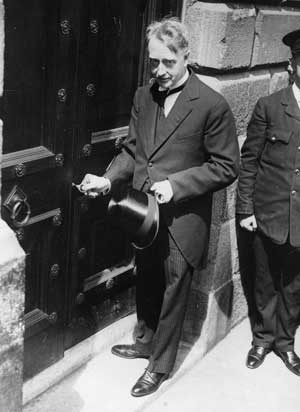W.T. Cosgrave takes office and introduces the Constitution
Published in Issue 5 (September/October 2022), Volume 30By Joseph E.A. Connell Jr

Above: W.T. Cosgrave, elected president of the Executive Council of the Third Dáil on 9 September 1922.
The Third Dáil ratified the Constitution (Bunreacht na hÉireann) of the Irish Free State on 18 September 1922. The document was drafted in the Shelbourne Hotel in the ‘Constitution Room’. The committee appointed to draft the Constitution was chaired by Michael Collins, but Darrell Figgis, the vice-chairman, was responsible for most of its drafting.
AN ACT TO ENACT A CONSTITUTION FOR THE IRISH FREE STATE (SAORSTÁT EIREANN) AND FOR IMPLEMENTING THE TREATY BETWEEN GREAT BRITAIN AND IRELAND SIGNED AT LONDON ON THE 6TH DAY OF DECEMBER, 1921.
DÁIL EIREANN sitting as a Constituent Assembly in this Provisional Parliament, acknowledging that all lawful authority comes from God to the people and in the confidence that the National life and unity of Ireland shall thus be restored, hereby proclaims the establishment of The Irish Free State (otherwise called Saorstát Éireann) and in the exercise of undoubted right, decrees and enacts as follows:—
- The Constitution set forth in the First Schedule hereto annexed shall be the Constitution of The Irish Free State (Saorstát Éireann).
- The said Constitution shall be construed with reference to the Articles of Agreement for a Treaty between Great Britain and Ireland set forth in the Second Schedule hereto annexed (hereinafter referred to as ‘the Scheduled Treaty’) which are hereby given the force of law, and if any provision of the said Constitution or of any amendment thereof or of any law made thereunder is in any respect repugnant to any of the provisions of the Scheduled Treaty, it shall, to the extent only of such repugnancy, be absolutely void and inoperative and the Parliament and the Executive Council of the Irish Free State (Saorstát Éireann) shall respectively pass such further legislation and do all such other things as may be necessary to implement the Scheduled Treaty.
- This Act may be cited for all purposes as the Constitution of The Irish Free State (Saorstát Éireann) Act, 1922.
W.T. Cosgrave had been elected president of the Executive Council on 9 September. Other cabinet members included: Ernest Blythe, Desmond FitzGerald, Patrick Hogan, Joe McGrath, Richard Mulcahy, Kevin O’Higgins (vice-president), James J. Walsh, Éamonn J. Duggan, and Fionan Lynch. Michael Hayes was Ceann Comhairle, Padraic Ó Maille Leas-Ceann Comhairle.
Seanad na hÉireann (Senate) also first met at the Shelbourne. In 1921 Arthur Griffith, as the leader of the Irish delegation at the Treaty negotiations, sought to ensure the status of the unionist and Protestant minority in a new Irish Free State. The day the Treaty was signed, Griffith met with southern unionist representatives and assured them of due representation in the Senate. Griffith did not live to realize his promise, but W.T. Cosgrave fulfilled his legacy.
Cosgrave appointed 30 senators in December 1922 and the Dáil elected a further 30. In all, seven peers, a dowager countess, five baronets and several knights were represented. The Senate consisted of 36 Catholics, 20 Protestants, three Quakers and one Jew. Cosgrave’s nominees numbered 16 southern unionists.
Anti-Treaty forces believed, however, that the Senate was designed primarily for the purpose of upholding the interests of the pro-British element in the Irish Free State. The execution of Erskine Childers in November 1922 introduced a new dimension to the ongoing Civil War. Anti-Treaty forces gave notice that senators were legitimate targets unless they resigned their office, but this request was rejected by the new senators. By the end of March 1923, 37 senators’ homes had been burnt to the ground.
The members included a number of representatives from the landed gentry as Griffith’s policy had been to utilize all sections of the country and his offer to ‘come and get the country under way’ was well received by Protestant unionists. The first presiding officer of the Seanad (Cathaoirleach Seanad na hÉireann) was Lord Glenavy, who had been an ally of Carson in 1912.
Joseph E.A. Connell Jr is the author of The Terror War: the uncomfortable realities of the Irish War of Independence (Eastwood Books, 2021).
















